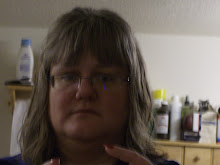She showed how to make patterns from your favorite skirt without taking it apart, using the rub off technique. I enjoyed the stories in her book, about how she started and got to this point, plus illustrations and photos.
Step one is that you need a pin board. I made mine from two foam boards, the kind kids use for school projects. I already had the boards. I sprayed one with craft spray and stuck the second board on top, I wanted the thickness for the push pins.
Step two. Collect all your materials. You need:
push pins
a long ruler
a curved ruler.
Pencil and
Paper scissors
Optional: Carol’s Pattern weights
Step Three lay the paper on the pin board.
Draw straight line down the front of the paper. This will assist in lining up the skirt.
Okay, my first pattern is of my favorite jean skirt. The skirt has six gores. When I measures the front panel is not the same size and the back panel. The two front side panels match and the two back side panels match.. The waist band is a simple rectangle I just measured. There are two side pockets sewn into the side seams. So I need to copy five pattern pieces.
Fold skirt in half and line up the fold with the line you just made. I turned my shirt inside out, but it’s not necessary. Smooth out the fabric making sure your seams line up
Step Four. According to the book, you place a push pin into the seams. I modified this part. I placed one pin at the waist band by the folded edge or along your line. This holds your skirt in place. Because of the length of my skirt, I placed another pin against, but not through the skirt about half way down the length. The plastic top of the push pin help the fabric in place. Then a third pin at the bottom of the skirt. Then you place pins along each seam. Once you’re done placing pins, you pull them out one at a time. I lifted the left waist band pin and fold the skirt out of the way and put the pin back into the same hole in the pin board. Do this to all the pins. Set aside the skirt.
Step Five. Use the long ruler to draw a line between each push pin. I pulled the pins up slightly and slid the ruler under the plastic top of the pin, so the ruler bumped against the pin part. Use a pencil to draw your lines. After I finished drawing the lines, the pencil marks didn’t show up very well in the photos so I traced them with a sharpie pen and the pen bleed through to my board.
Step Six. Mark your pattern and add seam allowances. Don’t forget to mark the fold. Cut out and you are ready to go. I made notes directly on the Swedish tracing paper. I also traced a favorite nightgown, I added the notes about lace and length of the spaghetti straps. I also marked the waistband information on panel A of the skirt.
One of the things I didn’t mention was how I made the pocket pattern piece I slid a notepad under the pocket and just traced it, I made notes of where I need to add seam allowances and where I don’t need to.
Repeat as necessary for each pattern piece. Label all the pieces. Steffani Lincecum recommended using a method of notches for placement to sew. I will use stickers marked piece A, B, B, C C, and D for my skirt panels.
Love this method, it made more sense than any of the other books about making patterns I have. I will use this technique a lot.
Pro: Quick and easy to understand
I owned everything but the notch maker (not a big deal)
Con: Easy to forget to add the seam allowance.
Once I made a few patterns I needed to slow down because of all the holes in my foam board.
This should be fixed once I make the fabric cover for my pin board. I can always flip the board around and at $5 a board I can have a new anytime. Steffani used acoustical tiles for her pin board. I thought about using some cork tiles I already hard, but I wanted my board a bit thicker for the push pins. I can always add the cork tiles later.









No comments:
Post a Comment